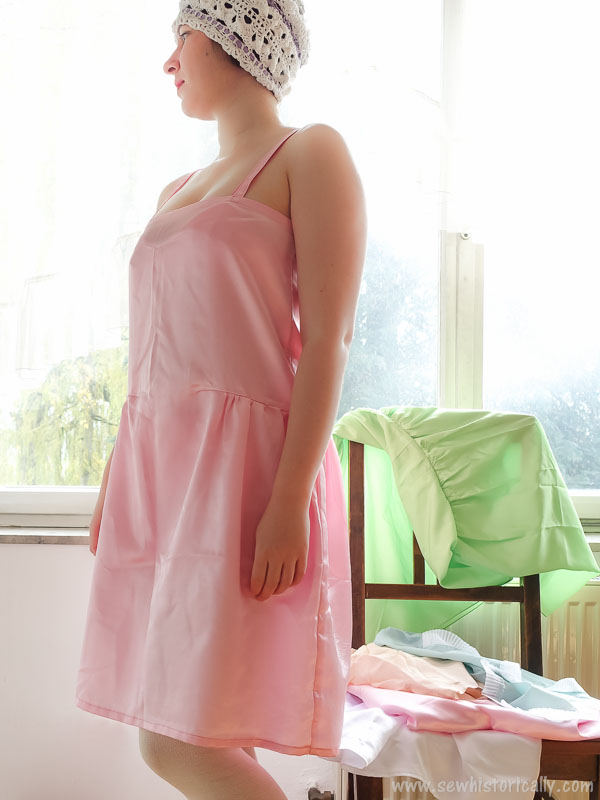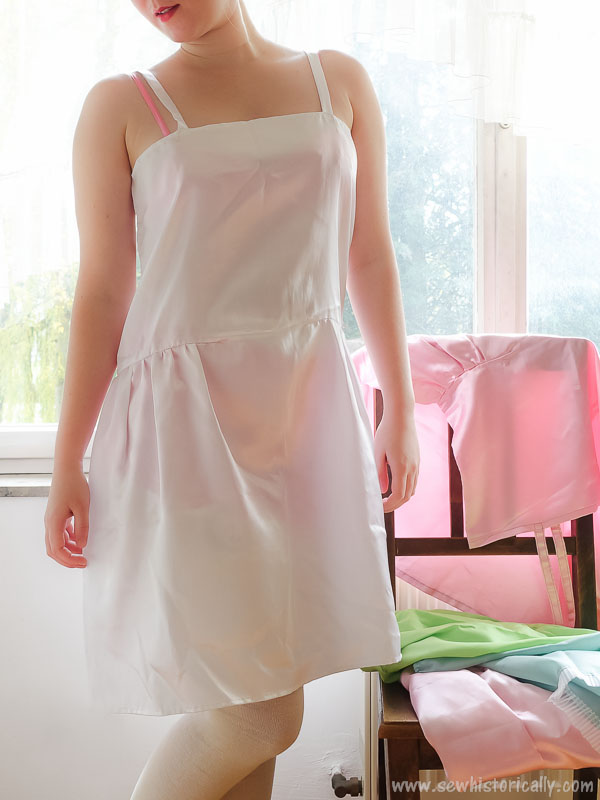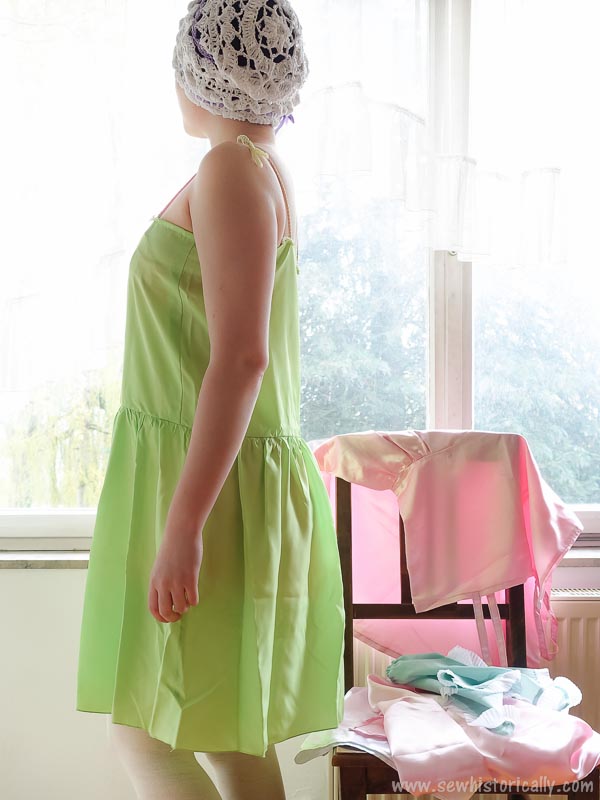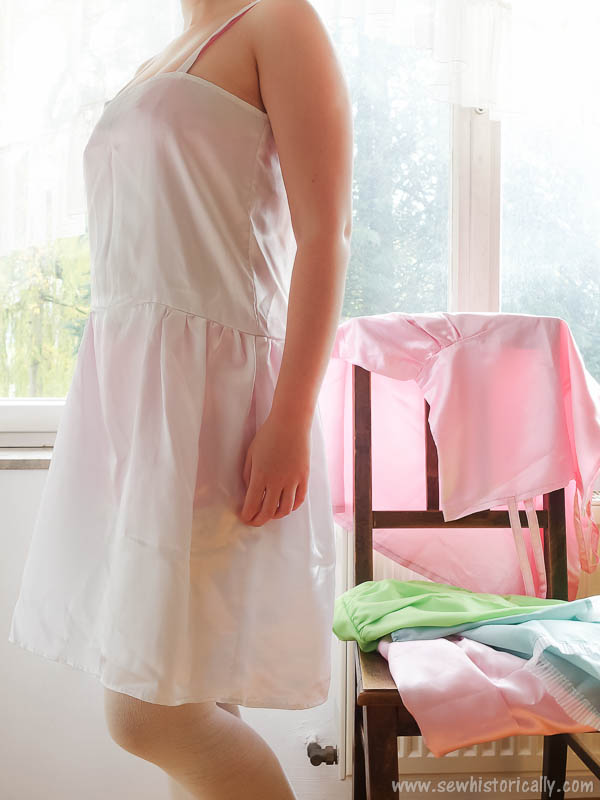1920s dresses are often very sheer so it’s absolutely necessary to wear a slip underneath!
Slips ‘are frequently used for wear under sheer summer dresses.’ (Clothing For Women: Selection, Design, Construction, 1917)
1920s slips came in different colors either to match the dress or to change the color of the sheer dress.
‘Colorful lingerie [is not worn] under transparent outer clothing. Exception is made in the case of a slip, which often provides the means of emphasizing a particularly pleasing color contrast and thus becomes a part of the outfit, or when the underwear matches the dress, even though the latter is sheer and of a bright color.’ (Underwear And Lingerie, 1925)
The Fabric
‘For wear in the home or under cotton dresses, sateen, long-cloth, […] or a light-weight muslin will be found satisfactory. For dressier wear, crepe de Chine, […] crepe-back satin, and pongee, as well as the knitted silks […] have the required smoothness […] [for] a wool or silk dress’. (Underwear And Lingerie, 1926)
For some of my 1920s slips I used historically accurate fabrics, such as silk, cellulose acetate and (woven) viscose (rayon) fabric. Historically accurate fabrics drape better but they wrinkle easily: So they require ironing! And especially silk is really expensive – and sometimes see through!
So for some of the 1920s slips I used polyester satin instead. While polyester satin is a bit stiff, a non-natural fabric and doesn’t drape as well, it’s cheap, opaque and doesn’t require ironing!
‘Some of the lining satins make attractive slips which will last a season, and are very inexpensive.’ (Clothing For Women: Selection, Design, Construction, 1917)
The Pattern
Sewing a 1920s slip is really simple and doesn’t even require a pattern! The top and bottom parts are just a rectangles!
Related: How To Make A 1920s Slip
‘A plain slip pattern with fullness at the sides. There is only one pattern piece as both back and front of such a slip are cut exactly alike.’
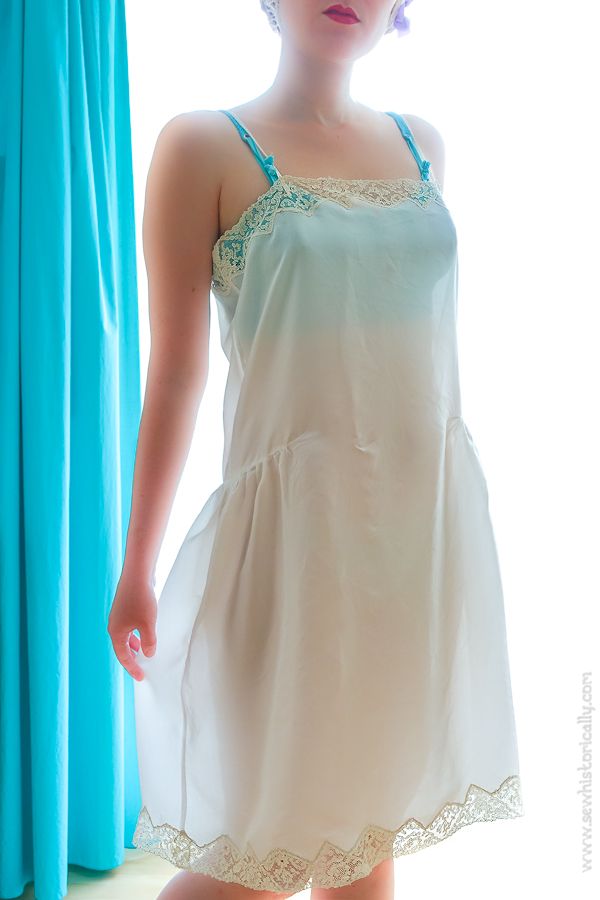
The Skirt Part
1920s slips are either gathered at the hips with the slash and gather technique, like this antique 1920s slip, or had a circular skirt or gathered skirt, like this antique 1920s slip.
The skirt part is ‘cut circular if of silk, or straight and gathered if of washable stuffs.’ (Clothing For Women: Selection, Design, Construction, 1917)
Lace Trim
1920s slips were often embellished with lace trim, especially at the top and hem of the slip. White or cream cotton Valenciennes and Mechlin lace seams to have been the most popular lace for Edwardian underwear.
In contrast to the more complicated lace insertion in the Edwardian era, in the 1920s, lace was usually just attached with zigzag stitches. I love doing Edwardian lace insertions but this 1920s technique is so much easier and faster! 😀
Related: 6 Ways How To Insert Lace – Historical Sewing Tutorial
The following 1920s lace-trimmed slips were my main inspirations for my 1920s silk slip and 1920s mint green slip: 1920s slip with a scalloped lace trim at the top and another 1920s slip with a scalloped lace trim. And on the following 1920s silk teddies you can see how the lace trim is attached with zigzag stitches: Valenciennes lace attached with zigzag stitches, scalloped tulle lace trim inserted with zigzag stitches and interior view of a 1920s silk teddy with lace trim.
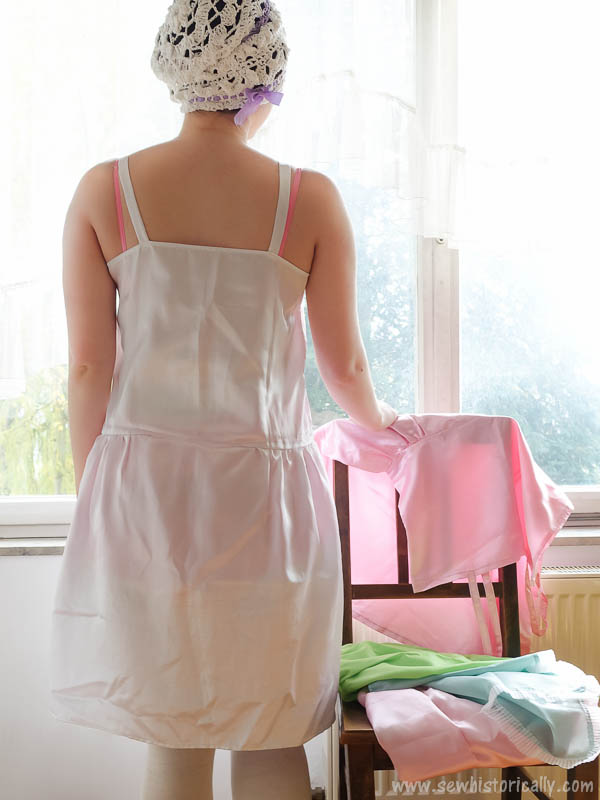
Plain 1920s Slips
I also made some plain 1920s slips. My plain 1920s slips are inspired by simple slips like this antique 1920s slip. You’ll find more antique 1920s slips and 1920s underwear on my pinterest board ‘1920s Lingerie’:
-> My Pinterest Board: ‘1920s Lingerie’
‘Not all persons want trimming on slips, especially on those for every-day wear, yet the finishes of even the plainest of slips can be considered trimming. For example, a machine-hemstitched hem virtually becomes trimming on either a cotton or a silk slip’. (Underwear And Lingerie, 1926)

1920s Slips For Sheer 1920s Dresses
Here you can see how the color of the slip changes the color of the dress. And click on the links below to see more of my sheer 1920s dresses worn with these 1920s slips:
-> Mint Green Chiffon Dress With White Silk Slip
-> White Lace Dress With Pink Satin Slip
1920s Underwear
Under the slips I’m wearing my 1920s tap pants, bra, girdle and stockings.
Related: 1920s Tap Pants
1920s Cap
And like all women in the 1920s, I’m wearing my DIY crochet lace cap to protect my 1920s finger waves! 😉
Related: Authentic 1920s Hairstyle Tutorial
